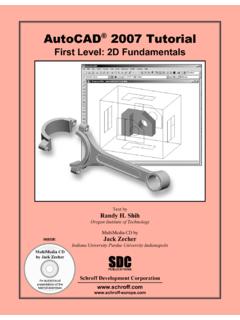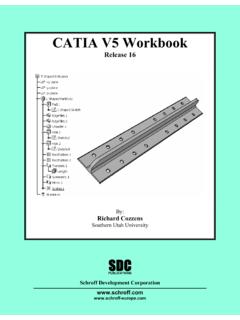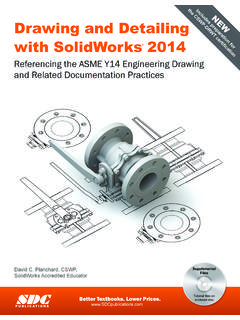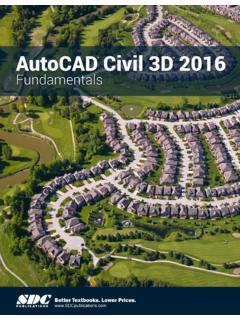Transcription of Technical Drawing 101 with AutoCAD 2015 - SDC …
1 Textbooks. Lower DiscIncludes Supplemental Files and Video InstructionDouglas Smith Antonio Ramirez Jana SchmidtTechnical Drawing 101 with AutoCAD 2015 A Multidisciplinary Curriculum for the First SemesterVisit the following websites to learn more about this book: Powered by TCPDF ( ) After studying the material in this chapter, you should be able to: 1. Explain what Technical drawings are. 2. Explain the terminology used to describe the process of creating Technical drawings . 3. Explain how Technical drawings are produced. 4. Explain the training needed to become an engineer, architect, designer, or drafter. 5. Describe the process of obtaining employment in the Technical Drawing field and the qualities that employers seek.
2 6. Describe what career prospects and opportunities, including salary ranges, are available in the field of Technical Drawing . Technical Drawing 3 Technical drawings are the graphics and documentation (including notes and specifications)
3 Used by manufacturers to fabricate electronic and mechanical products and by construction professionals to produce houses, commercial buildings, roads, bridges, and water and wastewater systems. In fact, Technical graphics are produced before almost all products are manufactured from the electronic devices inside your cell phone to the handle of your toothbrush. Refer to the following websites: American Design Drafting Association: American Institute of Architects: American Society for Engineering Education: National Society of Professional Engineers: Department of Labor: Technical Drawing 34 CHAPTER 1 Technical Drawing THE ORIGINS OF Technical Drawing Technical Drawing is not a new concept; archeological evidence suggests that humans first began creating crude Technical drawings several thousand years ago.
4 Through the ages, architects and designers, including Leonardo Da Vinci, created Technical drawings . However, a French mathematician, Gaspard Monge, is considered by many to be the founder of modern Technical Drawing . Monge s thoughts on the subject, G om trie Descriptive (Descriptive Geometry), published around 1799, became the basis for the first university courses. In 1821, the first English-language text on Technical Drawing Treatise on Descriptive Geometry, was published by Claudius Crozet, a professor at the Military Academy. Other terms often used to describe the creation of Technical drawings are drafting, engineering graphics, engineering drawings , and computer-aided design (CAD).
5 THE ROLE OF Technical Drawing IN THE DESIGN PROCESS To appreciate Technical Drawing s role in the design process, you must first under- stand some basics about design process itself. For most projects, the first phase of a design project is to define clearly the design criteria that the finished design must meet to be considered a success. Many designers refer to this phase in the design process as problem identification. For example, before designing a house, an architectural designer needs to know the size and style of home the client wants, the number of bedrooms and baths, and the approximate budget for the project. The designer also needs information about the site where the house will be built.
6 Is it hilly or flat? Are there trees, and if so, where are they located? What is the orientation of the site relative to the rising and setting of the sun? These concerns represent just a few of many design parameters that the designer needs to define before beginning the design process. Once the design problem is clearly defined, the designer begins preparing preliminary designs that can meet the parameters defined during the problem identification phase. During this step, multiple solutions to the design problem may be generated in the form of freehand sketches, formal CAD drawings , or even rendered three-dimensional (3D) models. Designers refer to this process of generating many possible solutions to the design problem as the ideation, or brainstorming, phase of the process.
7 The preliminary designs are shown to the client to determine whether the design is in line with the client s expectations. This step allows the designer to clarify the client s needs and expectations. It also is an opportunity for a designer to educate the client about other, possibly better, solutions to the design problem. After the client decides on a preliminary design that meets the criteria established in the first problem identification phase, the designer begins preparing design inputs that more clearly define the details of the design project. Design inputs may include freehand sketches with dimensional information, detailed notes, or even CAD models.
8 Figure shows an example of an architectural designer s sketch of a foundation detail for a house. When the design inputs are finished, they are given to the drafter(s) responsible for preparing the Technical drawings for the project. Drafters are individuals who have received specialized training in the creation of Technical drawings . THE ROLE OF Technical Drawing IN THE DESIGN PROCESS 5 One of the most important skills that drafters must acquire during their training is the ability to interpret design inputs and transform them into Technical drawings . Drafters usually work closely with other members of the design team, which may include designers, checkers, engineers, architects, and other drafters during the creation of Technical drawings .
9 CAD software can range in price from several hundred to thousands of dollars per station depending on the software. Figure shows an AutoCAD Drawing prepared from the designer s sketch shown in Figure Most drafters use CAD software to prepare the drawings . CAD allows drafters to produce drawings much more quickly than traditional drafting techniques. Popular CAD programs include AutoCAD , Revit , Autodesk Inventor , SolidWorks , and Pro/ENGINEER . When the drafter is finished preparing the Technical drawings , the designer, or in some cases a checker, reviews the drawings carefully for mistakes. If mistakes are found, or if the design has been revised, the drafter will make the necessary corrections or revisions to the drawings .
10 This process is repeated until the construction drawings are considered to be complete. When the entire set of construction drawings is finalized, the drafter and designer(s) put their initials in an area of the Drawing called the title block. JOB SKILLS Although modern drafters use CAD tools to create drawings , traditional drafting skills such as sketching and blueprint reading are still very important for facilitating communication between drafters and designers. Architectural Designer s Sketch of a Foundation Detail Detail Prepared from Architectural Designer s Sketch in Figure 6 CHAPTER 1 Technical Drawing The finished construction drawings represent the master plan for the project.










